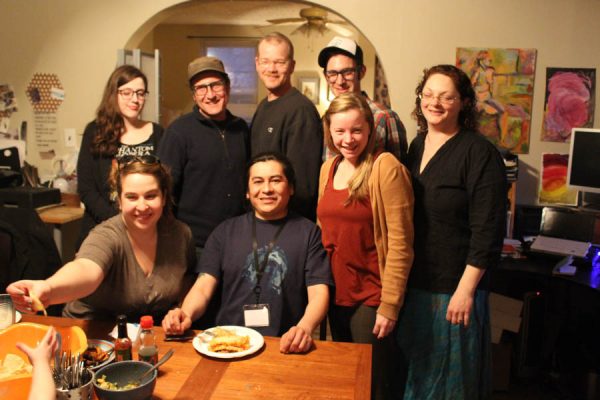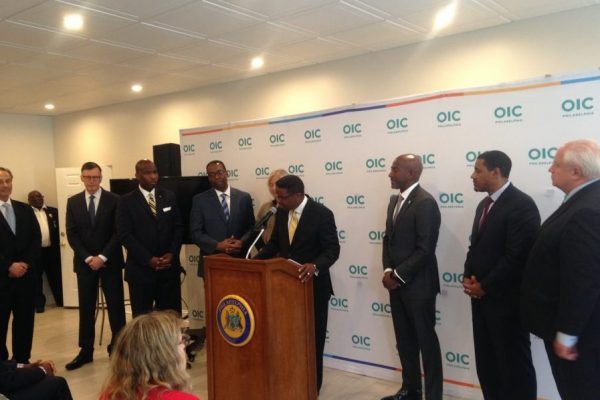A stroke of Irish luck landed me a Saint Patrick’s Day Parade VIP pass and a spot on the official Parkway reviewing stand. The ‘luck’ in this case was meeting Jane Duffin, Editor of The Irish Edition, the night before the parade and being told that she wanted to give away two coveted passes — one to me and the other to Marita Krivada Poxon, a local writer and author of Irish Philadelphia (Arcadia Publishing).
A VIP pass puts you smack on the reviewing stand with a host of dignitaries, namely city judges, politicians, Irish dignitaries, and the parade’s Grand Marshall. The reviewing stand, which stood some ten feet off the ground, was made of wood and had a partial roof. Seating capacity was about thirty folding chairs. A hospitality tent filled with a variety of lunch foods, coffee and soft drinks stood nearby. The theme of this year’s parade were the heroes of the 1916 Easter uprising.
Parades have never really rocked my world: Twirling batons, drums, high school marching bands, tasseled hats, little princesses in tin foil crowns, and small children waving flags just isn’t my idea of excitement. All of that changes, however, when you view a parade from a height of ten feet and when the passing bands stop and perform directly in front of you and the judges.
After watching the parade for a while, I felt something stir in my blood. It was the thought of how most of the people passing in front of me probably had direct links to the Irish that built Philadelphia. After all, there were labor union contingents, electrical workers, police and firefighters, fathers and sons, trombone players (some three sheets to the wind), singers and schools of toddlers (in Jeff hats) trying to dance traditional Irish dances. All were “lost” in the transcendent world of… The Parade.
From this sea of salty, ruddy faces some stood out as leprechauns while others towered in height, their white hair signaling a glimpse of lost Irish aristocracy. The performers were vying for high marks from the panel of judges, which included two Roman Catholic nuns in religious habits, a rare sight indeed.
I stood on the edge of the platform and noticed a man’s head at the tip of my right shoe. The man was standing in a corded-off grassy area about the size of a small alleyway. It was more of a restricted pathway for local news technicians, but this man did not look like a technician. He wore a tailored suit and his demeanor was calm and composed. I suspected it might be the mayor because his hair had Kenney’s familiar salt and pepper look, yet his torso seemed too thick. I had always assumed that the new Irish mayor had a slender, string bean kind of body, yet as I continued observing him, namely when he turned his head in the direction of the oncoming parade, I thought I saw the distinctive Kenney nose.
“Yes, that’s the mayor,” I said to Marita.
But what kind of mayor stands alone without security or an entourage? Mayor Nutter was famous for his entourage: serious looking men in dark suits with plugs and wires in their ears. Today, however, people were walking past the mayor as if he were a plain Mr. Joe Average from Bridesburg.
Since it seemed nobody else was recognizing him, I began to have doubts. “Maybe it’s not the mayor,” I said to Marita, but immediately after saying this, the man in the suit would turned head again and the same Kenney nose would come into view.
“That’s definitely Kenney’s nose. It is the mayor, yes. But why is he so invisible?”
I watched as more and more people walked in front of Kenney, all of them blissfully unaware that he was the mayor. It was 20 minutes or so before people began to notice him.
I spotted a woman in sunglasses walk up to Kenney and give him a hug. I recognized her as City Council member Helen Gym. I recalled her face from campaign photographs, especially the one of her raising her fist in a “Power to the People” salute while posing with Kenney for the Sanctuary City signing right after his inauguration.
Because they were barely 3 feet away from me, I studied their interpersonal dynamic. Gym was doing most of the talking — a lot of talking, in fact. She barely came up to the mayor’s shoulder. Their conversation lasted about fifteen minutes before Gym left, although I never saw her walk away because Marita was busy introducing me to a retired city judge. My eyes were also focused on the teams of Irish dancers and the sound their heels made when they came down hard on the portable wooden dance boards.
Gym’s hug-filled conversation, seemed to open the floodgates to the mayor, because soon after she left other people began to come up to him. I also heard a “Hi, Jimmy!” from a woman in one of the marching bands. She was walking along carrying a baby. After that a tall man rushed at the mayor from the body of the parade and said, “Hey, Jimmy, congratulations.” Kenney seemed to take it all in stride. Perhaps the pressures of City Hall had already ended the mayoral honeymoon.
At one point the mayor backed up tight against the edge of the platform and into the point of my shoe. He looked up at me as if to check out whose shoe it was and that whoever was behind him wasn’t poking him with something. Somebody had given him a beautiful green shirt that was folded as neatly as a flag that he placed on the edge of the platform, near my shoe. Every so often the mayor would glance sideways as if checking on the position of the shirt, or to see that it was still there. Twice when he left the small passageway to talk to somebody in another area, he’d come back and quickly eye the shirt. It seemed to me he that he was afraid that it might get stolen.
Eventually I saw that someone had brought him a chair. It was one of those plastic cafeteria chairs, but higher than most. The mayor was now sitting down so that his back was not smack up against the platform. A few times he’d look up at Marita. Since Kenney had met her before, he was able to give us both of us a nod. Somewhat later we would exchange a few words, parade cursory stuff, but at least it gave me time to introduce myself.
Parades, unfortunately, often harbor loud noises, explosions or ceremonial gunshots, and this parade to Saint Patrick was no exception to the rule.
A very loud ceremonial gunshot roared like fireworks over the heads of the crowd, causing the mayor to jump off his chair in what looked like an instantaneous spasm of panic. The chair wobbled and would have fallen to the ground had not the mayor caught it just in time. He braced himself against the chair and then looked up at Marita and me, smiled, and said, “I thought it was an execution firing squad!”
Yes, Mr. Mayor, we can only imagine the stress that being in a high position brings, especially given the violent and unpredictable state of the world today. Expect anything from anywhere, especially when it comes to violence, whether you’re in Miami, Newark, and Wilmington or… Brussels. Ironically, none of the roving, obsessively clicking photographers caught the mayor’s jump from the chair on camera, only Marita and I had seen the look of instant panic on his face.
Come to think of it, I’m glad that the obsessively clicking photographers were otherwise occupied.
All in a day’s work, as they say, although I did manage to tell the mayor that “we,” meaning Marita and I, “would protect him.” God knows how we would do that, but at least it felt like something nice to say.
The mayor stood in front of us for a good three hours. When he left, parade officials thanked him for spending so much time in attendance. Past mayors, apparently, were not as generous with their time, but Mayor Kenney is Irish.
At the parade’s conclusion, the mayor’s security detail finally came into view: a wired man in a dark suit and another city official in uniform. Perhaps they were seated in mini chairs under the platform out of our view all along, hiding under the boardwalk as it were.
The mayor, of course, was careful not to leave his beautiful green shirt behind.






